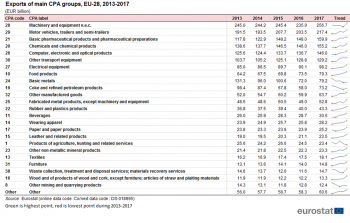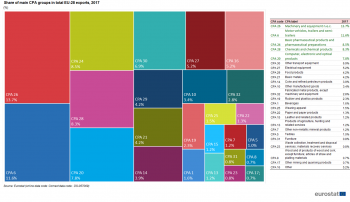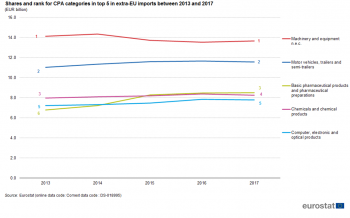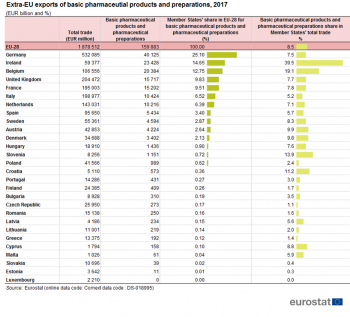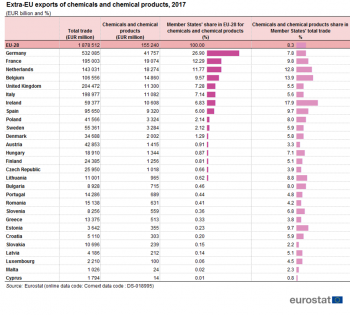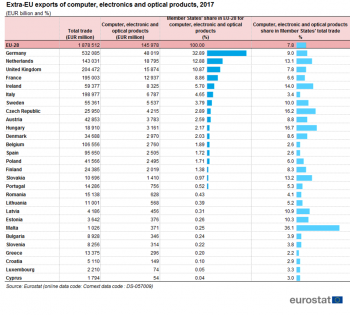Archive:Main goods in extra-EU exports
- Data extracted in September 2018. Most recent data: Further Eurostat information, Main tables and Database. Planned article update: September 2019
This article focuses on the most significant goods by value (according to the CPA classification) in extra-EU exports. It presents statistics for the EU-28 from 2013 to 2017. Statistics on goods traded between the EU and the world — especially the size and evolution of exports — enable the EU and national authorities to evaluate the health and competitiveness of EU industries. The article discusses the contribution of individual Member States to total extra-EU exports for the five most exported product groups and also shows the share these product groups have in each Member States total extra-EU exports of goods.
This article is part of an online publication providing recent statistics on international trade in goods, covering information on the EU's main partners, main products traded, specific characteristics of trade as well as background information.
EU-28 exports by CPA groups
The CPA classification consists of 40 products. The 24 most exported products (measured in value) are shown in Table 1 while the other 16 are grouped as "Other". For 20 of the products the highest exports were recorded in 2017. The four exceptions were all primary products: 'Basic metals', 'Coke and refined petroleum products', 'Products of agriculture, hunting and related services' and 'Other mining and quarrying products'.
Figure 1 shows the composition of total exports of goods in 2017 in the 24 CPA groups shown above in table 1. The top two products 'Machinery and equipment n.e.c.' and 'Motor vehicles, trailers and semi-trailers' together account for a quarter of all exports while the top five account of half of all exports. It is on this top 5 that the rest of article will concentrate.
Figure 2 shows that from 2013 to 2017 the top-5 products were almost continuously in the top 5. In fact only in 2013 there was an "outsider" in the top 5 which was basic metals which temporarily pushed pharmaceutical products to rank 6.Throughout the period the most exported product was machinery and equipment with a share close to 14 %. Motor vehicles had a share between 11 % and 12 %. The other three products all had shares between 6 % and 8 %. They appeared in different orders in 2013, 2014 and 2015, but from then on remained in the same order: pharmaceutical products before chemical products and computers, electronics and optical products.
Member States' exports of other machinery and equipment
Germany is responsible for more than a third of EU exports of 'Machinery and equipment n.e.c.' which is more than twice as much as the second largest exporter which is Italy (Figure 3). These exports make up 17.5 % of all German exports. Only Italy (21.9 %), Austria (18.5 %) and Luxembourg (18.3 %) have higher shares for this product group in their total exports of goods to countries outside the EU. Low shares are found in Ireland (2.0 %) and Greece (2.9%) while the for the EU as whole the share is 13.7 %.
Member States' exports of motor vehicles
German dominance in motor vehicles is even larger (Figure 4). On its own German extra-EU exports amount to over half of the total EU exports in this product group. They make up just over a fifth (21.0 %) of all German exports, a share similar to that of the Czech Republic (20.3%). Only Slovakia (45.2 %) has a higher share. For Cyprus, Malta, Greece and Ireland the shares are all below 1 % of their total exports. For the EU as whole this share is 11.6 %
Member States' exports of pharmaceutical products
Germany has a share of one quarter in extra-EU exports of pharmaceutical products; it is followed a some distance by Ireland (14.7 %) and Belgium (12.7 %) (Figure 5). Pharmaceutical products make up 7.5 % of all German extra-EU exports of goods which is one percent below the average for the EU. The share is highest in Ireland (39.5 %) but double digit shares are also found in Belgium (19.1 %), Slovenia (13.9 %) and Croatia (11.2 %). Slovakia, Estonia and Luxembourg all have shares below 1%.
Member States' exports of chemical products
The German share in extra-EU exports of chemicals (26.9 %) is larger than that of the next two, France (12.3 %) and the Netherlands (11.8 %) combined (Figure 6). Exports of chemicals make up 7.8 % of all German extra-EU exports which is half a percent less than the share for the EU as a whole (8.3 %). Three countries have double digit shares for extra-EU exports of chemicals in their total extra-EU exports. These are Ireland (17.9 %), Belgium (13.9 %) and the Netherlands (12.8 %). Only in Malta, Slovakia and Cyprus the share is below 3 %.
Member States' exports of computer, electronic and optical products
The German share for computer, electronic and optical products (32.9 %) is almost one third of total extra-EU exports of this product group (Figure 7). The next three countries combined, the Netherlands (12.9 %), the United Kingdom (10.9 %) and France (8.9 %) also have almost one third leaving the remaining one third for the other 24 Member States. Computer, electronic and optical products make up 9.0 % of all German extra-EU exports which is slightly higher than the 7.8 % for the EU as whole. The share is highest in Malta (36.1 %) while another eight Member States (Hungary, the Czech Republic, Ireland, Slovakia, the Netherlands, Latvia, Estonia and Sweden) have shares between 10 % and 20 % for this product group in their total extra-EU exports. The share is below 3 % in Greece (2.2 %), Belgium and Spain (both 2.6 %) and Croatia (2.9 %).
Source data for tables and graphs
Data sources
EU data is taken from Eurostat's COMEXT database. COMEXT is the reference database for international trade in goods. It provides access not only to both recent and historical data from the EU Member States but also to statistics of a significant number of third countries. International trade aggregated and detailed statistics disseminated via the Eurostat website are compiled from COMEXT data according to a monthly process.
Data are collected by the competent national authorities of the Member States and compiled according to a harmonised methodology established by EU regulations before transmission to Eurostat. For extra-EU trade, the statistical information is mainly provided by the traders on the basis of customs declarations.
EU data are compiled according to Community guidelines and may, therefore, differ from national data published by the Member States. Statistics on extra-EU trade are calculated as the sum of trade of each of the 28 EU Member States with countries outside the EU. In other words, the EU is considered as a single trading entity and trade flows are measured into and out of the area, but not within it.
Data for the other major traders are taken from the Comtrade database of the United Nations. Data availability differs among countries, therefore Figure 1 shows the latest common available year for all the main traders. For the calculation of shares the world trade is defined as the sum of EU trade with non-EU countries (source: Eurostat) plus the international trade of non-EU countries (source: IMF Dots database).
Methodology
According to the EU concepts and definitions, extra-EU trade statistics (trade between EU Member States and non-EU countries) do not record exchanges involving goods in transit, placed in a customs warehouse or given temporary admission (for trade fairs, temporary exhibitions, tests, etc.). This is known as ‘special trade’. The partner is the country of final destination of the goods for exports and the country of origin for imports.
Product classification
Classification of products by activity (CPA) is a statistical classification of products and services obligatory for all EU Member States. CPA classifies products by activity in which they are produced. Products are transportable goods and services. The CPA is a product classification whose elements are related to activities as defined by NACE Rev. 2. Each product - whether it be a transportable or a non-transportable good or a service - is assigned to one single NACE Rev. 2 activity. The linkage to activities as defined by NACE Rev. 2 gives the CPA a structure parallel to that of NACE Rev. 2 at all levels distinguished by NACE Rev. 2.
Unit of measure
Trade values are expressed in millions or billions (109) of euros. They correspond to the statistical value, i.e. to the amount which would be invoiced in the event of sale or purchase at the national border of the reporting country. It is called a FOB value (free on board) for exports and a CIF value (cost, insurance, freight) for imports.
Context
Trade is an important indicator of Europe’s prosperity and place in the world. The bloc is deeply integrated into global markets both for the products it sources and the exports it sells. The EU trade policy is an important element of the external dimension of the ‘Europe 2020 strategy for smart, sustainable and inclusive growth’ and is one of the main pillars of the EU’s relations with the rest of the world.
Because the 28 EU Member States share a single market and a single external border, they also have a single trade policy. EU Member States speak and negotiate collectively, both in the World Trade Organization, where the rules of international trade are agreed and enforced, and with individual trading partners. This common policy enables them to speak with one voice in trade negotiations, maximising their impact in such negotiations. This is even more important in a globalised world in which economies tend to cluster together in regional groups.
The openness of the EU’s trade regime has meant that the EU is the biggest player on the global trading scene and remains a good region to do business with. Thanks to the ease of modern transport and communications, it is now easier to produce, buy and sell goods around the world which gives European companies of every size the potential to trade outside Europe.
</articlecontent>
Further Eurostat information
Data visualisation
- Did you know? Some funny and curious facts about trade of the EU
- Top 5 partners in trade in goods
- My Country in a bubble
Main tables
- International trade in goods - long-term indicators (t_ext_go_lti)
- International trade of machinery and transport equipment (SITC 7), by declaring country (tet00009)
- Extra-EU28 trade of machinery and transport equipment (SITC 7), by Member State (tet00059)
- Extra-EU28 trade of machinery and transport equipment (SITC 7), by main partners (tet00030)
- International trade in goods - short-term indicators (t_ext_go_sti)
- Imports of goods - machinery and transport equipment (teiet170)
- Exports of goods - machinery and transport equipment (teiet070)
Database
- International trade in goods - aggregated data (ext_go_agg)
- International trade in goods - detailed data (detail)
Dedicated section
Methodology / Metadata
- International trade in goods statistics - background
- International trade in goods (ESMS metadata file — ext_go_esms)
- User guide on European statistics on international trade in goods
Source data for tables, figures and maps (MS Excel)
Other information — Legal background
- Regulation (EC) No 471/2009 of 6 May 2009 on Community statistics relating to external trade with non-member countries
- Regulation (EU) No 92/2010 of 2 February 2010 implementing Regulation (EC) No 471/2009, as regards data exchange between customs authorities and national statistical authorities, compilation of statistics and quality assessment
- Regulation (EU) No 113/2010 of 9 February 2010 implementing Regulation (EC) No 471/2009 , as regards trade coverage, definition of the data, compilation of statistics on trade by business characteristics and by invoicing currency, and specific goods or movements.
External links
Notes
[[Category:<Subtheme category name(s)>|Name of the statistical article]] [[Category:<Statistical article>|Name of the statistical article]]
